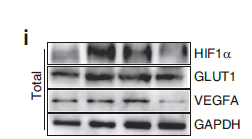
主要信息
Target
Ku-80
Host Species
Rabbit
Reactivity
Human, Mouse
Applications
WB, IHC, IF, ELISA
MW
80kD (Observed)
Conjugate/Modification
Unmodified
货号: YT2504
规格
价格
货期
数量
200μL
¥3,780.00
现货
0
100μL
¥2,300.00
现货
0
40μL
¥960.00
现货
0
加入购物车


已收藏


收藏
详细信息
推荐稀释比
WB 1:500-1:2000; IHC 1:100-1:300; ELISA 1:40000; IF 1:50-200
组成
Liquid in PBS containing 50% glycerol, 0.5% BSA and 0.02% sodium azide.
特异性
Ku-80 Polyclonal Antibody detects endogenous levels of Ku-86 protein.
纯化工艺
The antibody was affinity-purified from rabbit antiserum by affinity-chromatography using epitope-specific immunogen.
储存
-15°C to -25°C/1 year(Do not lower than -25°C)
浓度
1 mg/ml
实测条带
80kD
修饰
Unmodified
克隆性
Polyclonal
同种型
IgG
相关产品
抗原&靶点信息
免疫原:
The antiserum was produced against synthesized peptide derived from human XRCC5. AA range:441-490
展开内容
特异性:
Ku-80 Polyclonal Antibody detects endogenous levels of Ku-86 protein.
展开内容
基因名称:
XRCC5
展开内容
蛋白名称:
X-ray repair cross-complementing protein 5
展开内容
别名:
XRCC5 ;
Ku-80 ;
G22P2 ;
X-ray repair cross-complementing protein 5 ;
86 kDa subunit of Ku antigen ;
ATP-dependent DNA helicase 2 subunit 2 ;
ATP-dependent DNA helicase II 80 kDa subunit ;
CTC box-binding factor 85 kDa subunit ;
CTC85 ;
CTCBF ;
DNA repair pr
Ku-80 ;
G22P2 ;
X-ray repair cross-complementing protein 5 ;
86 kDa subunit of Ku antigen ;
ATP-dependent DNA helicase 2 subunit 2 ;
ATP-dependent DNA helicase II 80 kDa subunit ;
CTC box-binding factor 85 kDa subunit ;
CTC85 ;
CTCBF ;
DNA repair pr
展开内容
背景:
The protein encoded by this gene is the 80-kilodalton subunit of the Ku heterodimer protein which is also known as ATP-dependant DNA helicase II or DNA repair protein XRCC5. Ku is the DNA-binding component of the DNA-dependent protein kinase, and it functions together with the DNA ligase IV-XRCC4 complex in the repair of DNA double-strand break by non-homologous end joining and the completion of V(D)J recombination events. This gene functionally complements Chinese hamster xrs-6, a mutant defective in DNA double-strand break repair and in ability to undergo V(D)J recombination. A rare microsatellite polymorphism in this gene is associated with cancer in patients of varying radiosensitivity. [provided by RefSeq, Jul 2008],
展开内容
功能:
developmental stage:Expression increases during promyelocyte differentiation.,Disease:Individuals with systemic lupus erythematosus (SLE) and related disorders produce extremely large amounts of autoantibodies to p70 and p86.,Domain:The EEXXXDDL motif is required for the interaction with catalytic subunit PRKDC and its recruitment to sites of DNA damage.,Function:Single stranded DNA-dependent ATP-dependent helicase. Has a role in chromosome translocation. The DNA helicase II complex binds preferentially to fork-like ends of double-stranded DNA in a cell cycle-dependent manner. It works in the 3'-5' direction. Binding to DNA may be mediated by p70. Involved in DNA nonhomologous end joining (NHEJ) required for double-strand break repair and V(D)J recombination. The Ku p70/p86 dimer acts as regulatory subunit of the DNA-dependent protein kinase complex DNA-PK by increasing the affinity of the catalytic subunit PRKDC to DNA by 100-fold. The Ku p70/p86 dimer is probably involved in stabilizing broken DNA ends and bringing them together. The assembly of the DNA-PK complex to DNA ends is required for the NHEJ ligation step. In association with NARG1, the Ku p70/p86 dimer binds to the osteocalcin promoter and activates osteocalcin expression.,induction:In osteoblasts, by FGF2.,PTM:Phosphorylated on serine residues. Phosphorylation by PRKDC may enhance helicase activity.,PTM:Sumoylated.,similarity:Belongs to the ku80 family.,similarity:Contains 1 Ku domain.,subunit:Heterodimer of a 70 kDa and a 80 kDa subunit. The dimer associates in a DNA-dependent manner with PRKDC to form the DNA-dependent protein kinase complex DNA-PK, and with the LIG4-XRCC4 complex. The dimer also associates with NARG1, and this complex displays DNA binding activity towards the osteocalcin FGF response element (OCFRE). In addition, the 80 kDa subunit binds to the osteoblast-specific transcription factors MSX2 and RUNX2. Interacts with ELF3. May interact with APLF.,
展开内容
细胞定位:
Nucleus . Nucleus, nucleolus . Chromosome .
展开内容
组织表达:
Cervix carcinoma,Coronary artery,Heart,Neuroblastoma,Osteoblast,Thy
展开内容
研究领域:
>>Non-homologous end-joining
展开内容
文献引用({{totalcount}})
货号: YT2504
规格
价格
货期
数量
200μL
¥3,780.00
现货
0
100μL
¥2,300.00
现货
0
40μL
¥960.00
现货
0
加入购物车


已收藏


收藏
Recently Viewed Products
Clear allToggle night Mode
{{pinfoXq.title || ''}}
Catalog: {{pinfoXq.catalog || ''}}
Filter:
All
{{item.name}}
{{pinfo.title}}
-{{pinfo.catalog}}
主要信息
Target
{{pinfo.target}}
Reactivity
{{pinfo.react}}
Applications
{{pinfo.applicat}}
Conjugate/Modification
{{pinfo.coupling}}/{{pinfo.modific}}
MW (kDa)
{{pinfo.mwcalc}}
Host Species
{{pinfo.hostspec}}
Isotype
{{pinfo.isotype}}
产品 {{index}}/{{pcount}}
上一个产品
下一个产品
{{pvTitle}}
滚轮缩放图片
{{pvDescr}}




















